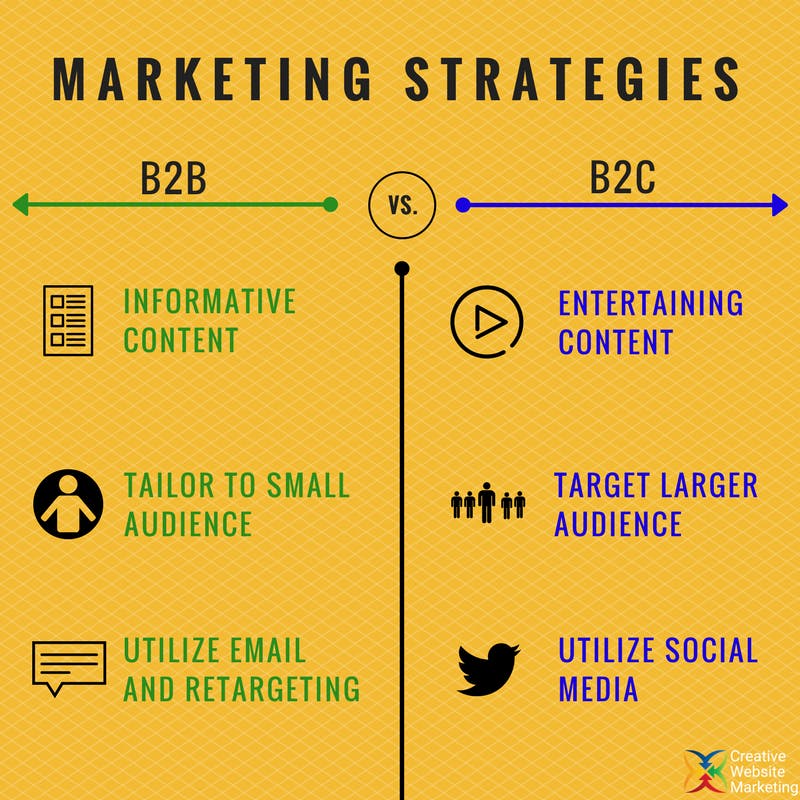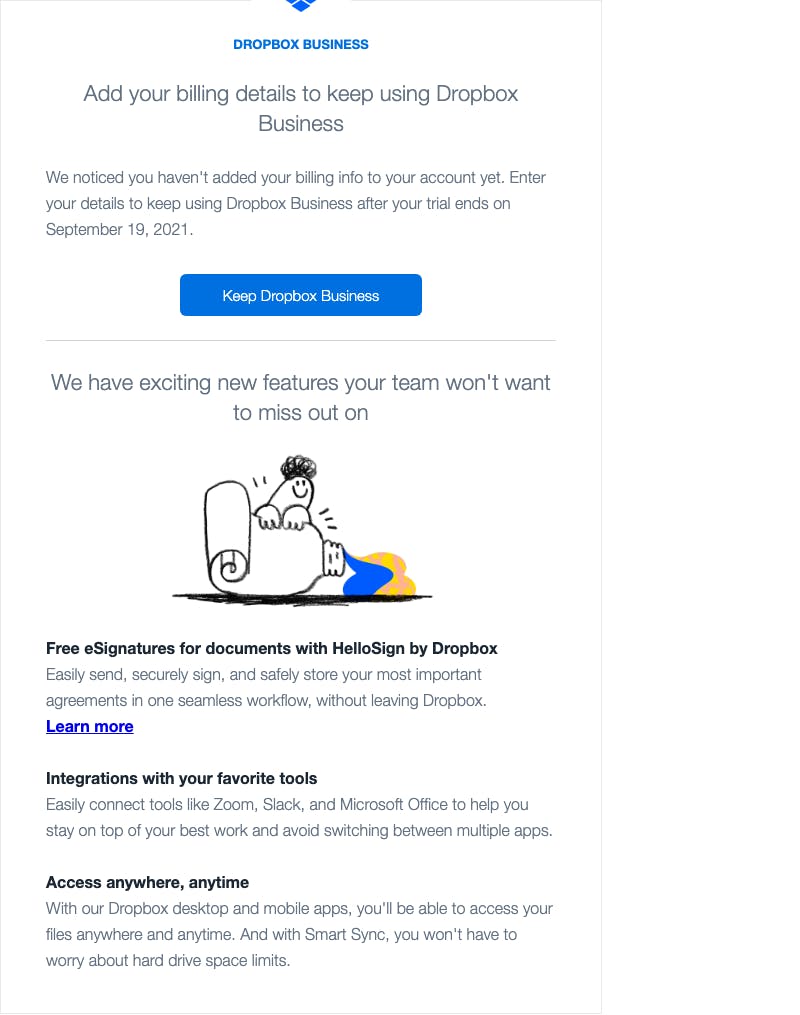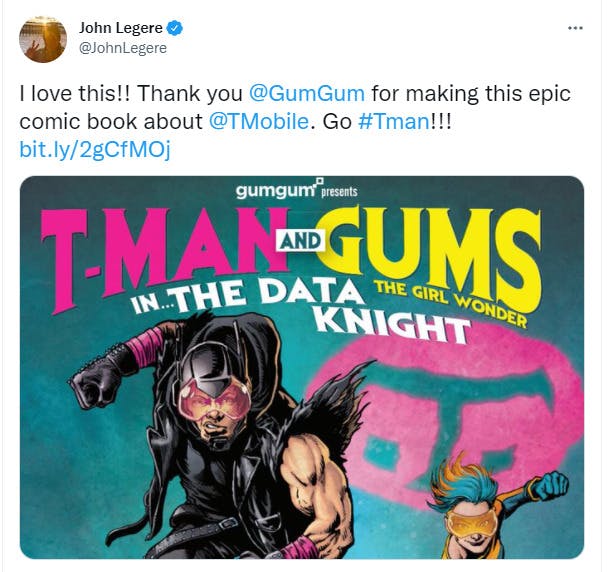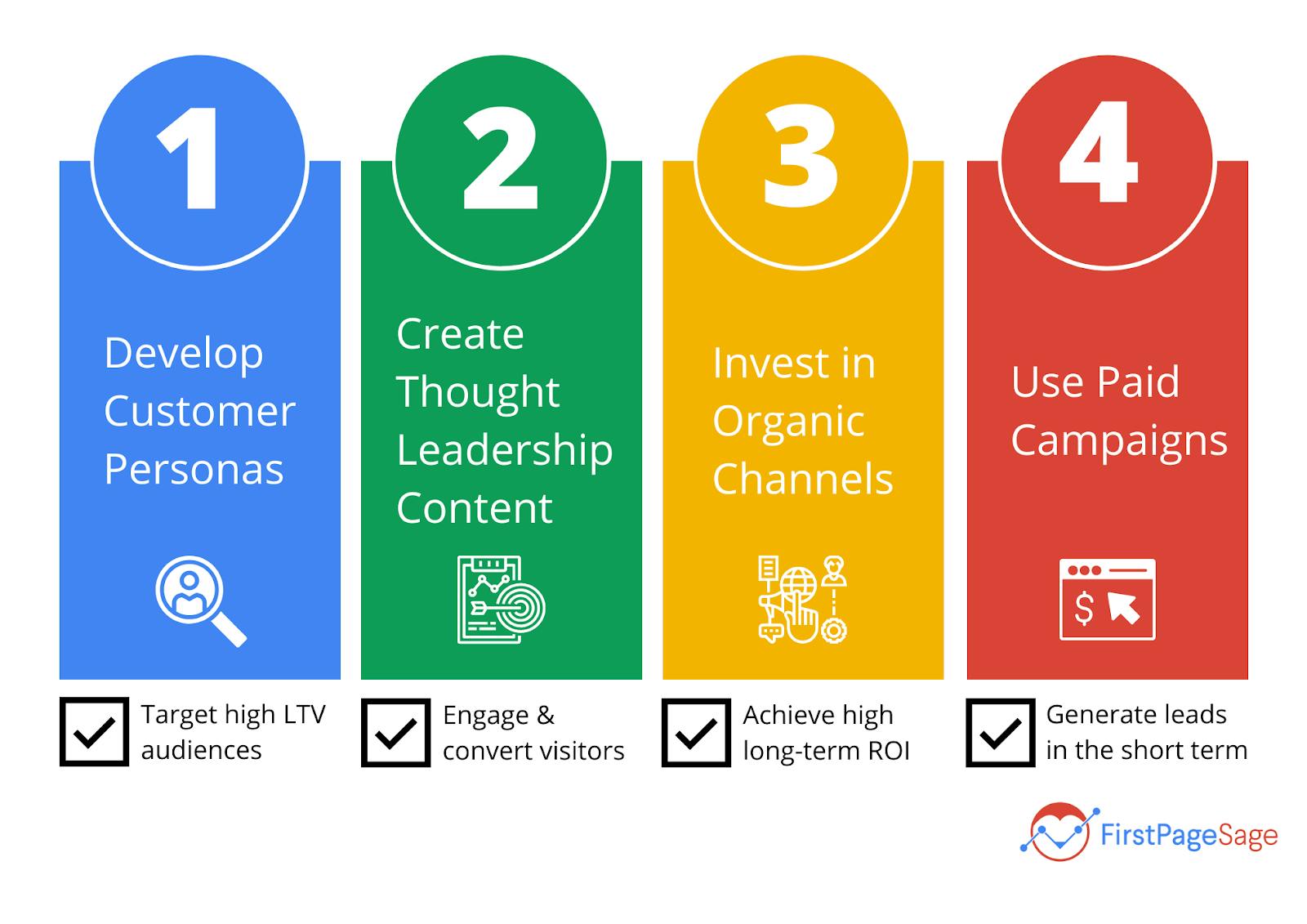What is B2B marketing: strategies and examples
Jul 12th, 2022

Contents
What is B2B marketing?
B2B marketing strategies and examples
B2B marketing planning
Marketing automation in B2B
Mastering B2B marketing may seem like a challenging task. While B2C marketing is focused mainly on building awareness and appealing to emotions, B2B marketing is built around expertise, knowledge, and practical value. Moreover, the most difficult task for a B2B company is to promote the product to an entire board of decision-makers and convince them to make a choice in your favor.
If you want to learn about B2B marketing, the most powerful tactics, and the ways to achieve success in this field, keep reading. In this guide, we will clarify each component of modern B2B marketing strategies.
What is B2B marketing?
B2B or business-to-business marketing is the process of marketing products or services to other companies. B2B marketing encompasses all activities and procedures used to promote or deliver a product or service to another business. Business-to-business operations occur between two companies, rather than between a business and an individual customer, in contrast to B2C or business-to-consumer marketing.
Business-to-business marketing can also be defined as the practice of promoting products or services to other firms for manufacturing, routine business operations, and resale to other customers. This marketing type is more complex than promoting consumer products as it typically involves large sales volumes, lengthy sales cycles, and numerous decision-makers. B2B marketing is frequently used by companies that manufacture specific products like plastic, steel, or fabric or offer various services, such as SaaS subscriptions, SEO, or project management.
The purpose of B2B marketing is to increase awareness among other companies, highlight the benefits of products and turn the organizations into clients. The first step of the strategy is to attract the attention of the other businesses, generate interest in a product, and nurture leads to convert them into customers. It begins with identifying marketing opportunities and customizing the marketing message to target a certain type of business. Then company aims to establish a long-term relationship with consumers.
In business-to-business marketing, developing valuable relationships is crucial as B2B products and services are often more sophisticated and expensive than those marketed to individual customers. In addition, it is uncommon for a company to have a fully autonomous production and distribution process. As a result, businesses seek to choose the right partner to make a long-term investment and find a suitable producer and supplier of products. Moreover, B2B relationships provide the potential for increased revenue. Selling to consumers typically entails making a single low-cost purchase, while B2B sales often involve a substantial cost of a product or service and a long-term contract.
Although B2B and B2C marketing have similar objectives, their strategies are dramatically different.
B2B vs B2C marketing
Let us consider the primary differences between B2B and B2C marketing. Once you identify the distinctive features of B2C marketing, it is easier to understand the B2B marketing principles.
The first significant difference is the target audience. Business-to-consumer marketing focuses on promoting products and services to individual buyers for personal use and consumption. B2C companies address the needs, interests, and challenges consumers face daily. Examples of B2C purchases are groceries, shoes, or toothpaste. Furthermore, B2C companies provide services like music streaming subscriptions, taxi journeys, or photography classes. In contrast, B2B products are aimed at any type of company. These can include equipment or materials for manufacturers or software that enables businesses to store information about their clients. Consequently, B2B marketers usually target influential business decision-makers instead of end-user or the entire company.

The other considerable difference is the length of the buying cycle. The B2B decision-making process is typically much longer as it requires careful consideration of user experience and more complex lead nurturing. Before making a B2B purchase, the heads of several departments need to ensure that the product helps achieve the company’s long-term goals. Moreover, the length of the B2B sales cycle can depend on the extended implementation process when the team members become acquainted with the product.
The next distinction between B2B and B2C marketing lies in the average budget per customer. While B2B products are designed for companies with sizable budgets, B2C offers are intended for customers with a limited disposable income. As B2C items are often less expensive, businesses need to rely on a large number of purchases to accomplish their objectives. Thus, business-to-consumer companies use marketing channels targeted at a mass audience, such as paid social media advertisements. At the same time, B2B products are sold at a higher price, and business-to-business marketing campaigns focus more on reaching the appropriate audience instead of trying to attract more clients.
Finally, B2C marketing relies on influencing consumers’ emotions to motivate customers to make purchasing decisions. Therefore, business-to-consumer marketing aims to entertain the target audience and provide fun content like YouTube reaction videos or TikTok clips. B2B purchases, on the contrary, are primarily driven by logic, so marketers pay greater attention to producing educational content. B2B customers need to be properly informed about the products they purchase, so the marketing content should demonstrate how the offer helps achieve business objectives and how it can benefit a company. Moreover, business-to-business marketing is more personalized compared to the B2C strategy and involves getting to know each team member and tailoring products and content to their requirements.
Once we have analyzed how B2B marketing differs from the B2C approach, let us take an in-depth look at the most common B2B marketing strategies.
B2B marketing strategies and examples
In this section, we will discuss different B2B marketing techniques you may use to target a particular business audience.
Email marketing in B2B
Business-to-business email marketing is a specific type of email marketing strategy aimed at targeting businesses rather than individual clients. According to a study by Content Marketing Institute, 81% of B2B marketers use email newsletters more frequently than other types of content marketing. And the reason is simple: email marketing is the most cost-effective channel with the highest ROI. The statistic shows that email marketing may bring up to $70 for every $1 invested. Thus, email marketing is an affordable way to generate leads and create long-lasting relationships with customers, even though blogs and social media are gaining more attention from B2B marketers these days.
How to use it
The first step to implementing an effective B2B marketing strategy is to segment the audience into groups according to geography, firmographics, similar needs, traits, and behavior. The following step is to build detailed buyer personas and create lists of email addresses. Then you need to develop special offers, create relevant blog articles, or prepare information about upcoming events for each target group.
Your key to success is a strong subject line of an email. It will determine whether the email gets high open rates or is deleted without being read. The compelling subject line should evoke curiosity and capture potential customers’ purchase intent. Make your emails informative and educational, and include one powerful call to action. To gain your customers’ interest, you need to create a series of emails as a part of a lead nurturing campaign. Send the emails daily, weekly, or monthly to keep customers engaged and entice them to return for more.
Dropbox, the file hosting service, creates emails containing announcements, reminders of the new features, and information on functionality. Dropbox uses animations and simple design to display the data creatively. It makes emails more engaging and motivates users to open them more frequently. What’s more, the company provides helpful tips on improving customers’ experiences and emphasizes a product’s practical use. Thus, Dropbox allows businesses to get more value from their service.

Content marketing in B2B
B2B content marketing is the practice of creating and delivering content to increase brand recognition and traffic and generate leads and sales for SaaS companies or other business-to-business organizations. The most common B2B content marketing formats are blogs, podcasts, email newsletters, webinars, case studies, and infographics.
While B2C and B2B content marketing strategies start with identifying the audience’s pain points and end with driving sales, there is a massive difference in buyers’ motivation, decision-making process, and customer journey. B2C content is aimed at entertaining and engaging the audience by creating a strong emotional bond with the brand. On the other hand, B2B content marketing focuses on educating, motivating, and engaging potential customers while addressing their pain points.
How to use it
Start with identifying your target audience and developing buyer personas. Then segment the audience into groups according to their buyer behavior, geography, needs, or firmographics. Choose one or two specific segments and determine their unique requirements to adapt the content to these demands. Next, include the appropriate short and long tail keywords in the website articles and blog posts to allow the target audience to find your brand through the search engines.
Analyze your competitors’ content and determine their strengths and weaknesses. Develop the company’s unique selling proposition by highlighting your advantages. Create multi-layered content that includes text, images, and videos to provide an aesthetically appealing user experience. Collaborate with other businesses and make guest posts to build brand awareness. Finally, promote your content on different social media platforms to improve your website’s visibility on search engines.
HubSpot is a marketing company that develops software tools for inbound marketing, sales, and customer service. The company has produced two types of content to address different stages of the sales funnel. The first type of content is blog posts that educate small businesses about digital marketing and draw visitors to the top of the funnel. The other content includes case studies, webinars, eBooks, and marketing materials aimed at visitors in the middle and the bottom of the funnel. As a result, HubSpot succeeded in becoming a public company with a market capitalization of $14 billion thanks to its content marketing strategy.
Social media marketing in B2B
Social media is the most suitable channel for developing brand recognition. Top-of-the-funnel marketing is crucial for B2B companies as customers may need weeks or even months to proceed to the next stage of the sales funnel. According to statistics by Optinmonster, 84% of business-to-business executives use social media before making purchasing decisions. With social media, brands can position themselves as thought leaders by sharing useful information and educating the audience. In addition, social media allows marketers to adopt a more personalized approach by using targeted messages and providing customer support. The most popular social media platforms for B2B companies include LinkedIn, Twitter, Facebook, YouTube, and Instagram.
How to use it
First, you need to set goals and determine specific and measurable key performance indicators, such as gaining a certain number of followers and increasing conversions, traffic, or engagement. Secondly, you need to choose the platforms to track KPIs. For example, you can use Google Analytics to understand what social media networks are driving the most website traffic. After this, focus on several channels taking into account the characteristics and needs of your target market.
Consider the content that resonates with your existing and potential customers. Research your competitors’ social media pages to understand how to differentiate your brand from other businesses. Categorize your content topics by developing content pillars. You can divide the content into four types: educational content like infographics, how-to guides or tutorials, promotional content, such as press releases, content that provides support like webinars, online courses or podcasts, and content that builds trust like testimonials and case studies. The last step is to monitor your social media performance and analyze whether you have reached the desired KPIs.

A technology corporation IBM uses social media marketing to tell about its history and legacy in the industry. The company publishes photos and videos of the products from the past 100 years on Instagram to establish credibility and demonstrate that the business has experienced ongoing success for a long period. IBM educates the audience on complex topics like quantum computing and novel technologies. The corporation also encourages employees to discuss their experiences working at IBM. All of the company's social media content reflects its values, including innovation, personal responsibility, and reliability.
Video marketing in B2B
Video marketing is an effective tool that allows B2B organizations to interact with the audience on social media, promote products and services through customer testimonials, and educate consumers with product demos. 86% of marketers claim that video is helpful in generating leads. The greatest advantage of video content is the ability to share it on various platforms, which allows marketers to provide more information about the product in a clear and digestible way. It is an excellent method to capture the audience’s attention as the video combines text, audio, and visuals in one format. Additionally, Google places videos at the top of search results, so it can improve your website ranking.
How to use it
You should begin by setting a clear goal for your video marketing campaign. Establish the key success metrics to make sure that your team is working towards the same objective. Research the target market to understand customer needs and develop buyer personas. Decide on the budget for video production, find the right video producer or production team, and choose the types of video that fit into the overall content strategy. Consider the following types of B2B marketing videos: case studies, testimonials, product videos, brand videos, whiteboard videos, interviews with industry experts, and explainers. Once you have chosen the appropriate type and calculated the budget, select the platform to publish the video to reach your target audience. The final steps are to promote the video and track the results to understand what you can improve in the future.
A tech giant Intel uses storytelling within its video marketing strategy to illustrate the experiences and stories of the broad customer base. In contrast to other B2B companies, the computer chip manufacturer does not concentrate on tutorials and instructions. Instead, their YouTube channel covers a variety of topics, including wildlife photography, gaming, and aerial cinematography. The company also shares videos where Intel’s employees tell their personal stories of success.
Influencer marketing in B2B
Influencer marketing is a branch of marketing that focuses on involving influential people to promote a brand message to a wider audience. B2B organizations often use influencer marketing in combination with content marketing and social media marketing. By using influencer marketing, your company can position itself as an industry thought leader, provide a unique point of view that resonates with your audience and give you access to valuable business contacts.
How to use it
One of the most difficult tasks for B2B marketers is to find the right influencers. The success of B2B influencer marketing strategy depends mostly on the quality of the influencer’s content instead of the number of followers. Thus, it is better to choose niche bloggers with an engaged audience rather than influencers with millions of inactive subscribers.
The most effective way to find influencers is to use specialized databases or search for the thought leaders in your niche. After that, you need to choose a platform that matches the company’s tone of voice and where you can reach the target audience. The next step is to prepare a list of influencers you are interested in. You may include the number of subscribers, views, and engagement rate in the list. Finally, it is time to evaluate the bloggers and celebrities and pick the ones with highly engaged followers.
American Express widely employs B2B influencer marketing on Instagram. A good example is the #AmexAmbassadors campaign. The corporation launched the campaign to promote the Platinum card and partnered with celebrities and Instagram bloggers to target the desired audience. American Express chose the influencers who led luxurious lifestyles and traveled regularly. They shared pictures of their vacations and the exclusive locations they visited with the American Express Platinum card. One of the chosen influencers was Keke Palmer. Her post received more than 60,000 likes.
Account-based marketing in B2B
Account-based marketing, also known as key account marketing, combines the competencies of sales and marketing teams to target best-fit accounts and turn them into customers. Instead of sticking to the traditional B2B sales funnel, account-based marketing identifies and focuses on potential clients with the highest chances of becoming customers. Then marketers can use technology to deliver personalized messages to decision-makers on the platforms they are actively using.
How to use it
Successful account-based marketing uses a multichannel strategy and involves close coordination between a company's sales, marketing, and customer success departments. First, marketing and sales teams identify the prospects or accounts they are going to target. The next step is to develop a marketing campaign aimed at potential customers and personalize messaging, website copy, and emails. The final step is to implement a system that allows for monitoring of the progress. The key metrics will include likes and comments on social media rather than clicks or page views. If some account shows signs of increased engagement, it is time for the sales department to get in touch.
GumGum, a digital advertising technology company, used account-based marketing to collaborate with the communication company T-Mobile. Once GumGum discovered that T-Mobile CEO John Legere was a huge Batman fan, the company created and printed a comic book called T-Man and Gums and distributed it across T-Mobile offices. This is a great example of account-based B2B marketing when a business discovered information about the target audience and used that knowledge to produce content based on consumers’ interests.

Affiliate marketing in B2B
Business-to-business affiliate marketing involves engaging reputable content creators, such as industry bloggers or social media influencers, to promote the company on their channels. The influencers add links to your website to their social media pages. When a person makes a purchase or turns into a lead, the affiliate receives the commission. Giving your affiliates a commission on each sale motivates them to contribute to the development of your brand.
How to use it
Conduct research and find the right affiliates in your niche. Pay special attention to B2B professionals and industry experts who create high-quality content that resonates with your audience and aligns with your brand. List people who match these requirements and those who are already familiar with your product or service. Next, set the goals and focus on key performance indicators, which may include the amount of income you hope affiliates will bring on a quarterly or annual basis, the number of qualified leads you want to attract per year, and the number of sales generated by affiliate links.
When determining the commission for your affiliates, assess client acquisition costs, average customer lifetime value, and retention rate. Make sure your commission is reasonable compared to your direct rivals and other businesses in the industry. The ideal solution is to provide a fixed percentage of every sale, a fixed commission for each transaction, or a reward for each qualified lead that meets specific requirements. You can create your own affiliate network to save money, educate the affiliates on the sales cycle and have better control over the affiliate program. Monitor the results and make any necessary changes based on analysis and feedback.
Wix is a website design platform that provides hosting services. The company offers an affiliate program to market its products. The affiliates receive a $100 commission with the opportunity to earn bonuses if the number of conversions exceeds a predetermined threshold. The participants have access to the knowledge base, detailed statistics, and customizable reports. They can learn how to drive conversions more effectively, track progress, and check payments. The program is available in many different languages, so people from all over the world can participate.
We have discussed examples of companies that have successfully implemented B2B marketing techniques in their everyday operations. In the next section, we will learn how to plan and implement a B2B marketing strategy for your company.
B2B marketing planning
Now let us discuss the most crucial steps of B2B marketing planning in more detail.
The first step of your go-to-market strategy as a B2B company is to create buyer personas to target the desired audience effectively. Conduct interviews with customers to identify their pain points, understand their needs, and determine why they prefer your products over the competitors’ offers. Gather information about their job titles, daily functions, challenges they face in their work, and KPIs used by their managers to assess their performance.
The following step is to produce thought leadership content to hold website visitors’ attention and turn them into customers. Creating valuable content increases your conversions and website engagement rate and lays the foundation for all the channels you decide to use later. In the future, you can repurpose your website content and transform it into webinars or whitepapers.

The third step is to invest in organic channels with high ROI. These may include SEO, videos, webinars, email, podcasts, and LinkedIn posts. Use the organic channels to distribute the useful content we have mentioned above.
The final step is to use paid channels for short-term lead generation. Even though organic channels are effective at generating leads, they have one significant drawback: they are slower than paid channels and require considerable investment before they begin to pay off. Thus, you can make focused one-time investments in addition to organic efforts. For example, you can run a series of pay-per-click ads and determine the one which will show the best ROI.
Next, we will examine the marketing automation tools that will help you implement a B2B strategy without much effort.
Marketing automation in B2B
We will categorize B2B marketing automation software by three use cases: all-in-one automation tools, email marketing automation, and customer journey automation tools.
All-in-one marketing automation platforms combine several functions and can be used for email automation, lead nurturing, ad buying, and much more. If you have already achieved good results with one or two channels and want to experiment with the additional platforms or scale the working ones, then you can try all-in-one marketing automation tools. These are Omnisend, Marketo, HubSpot, and Pardot.
Email marketing automation tools have a wide range of useful features: the ability to create personalized automated campaigns, resend unopened emails, A/B testing, and send segmented follow-up emails. If you want to increase open rates and customer engagement, try Mailchimp, Automizy, Constant Contact, and Drip.
Customer journey automation tools are designed to simplify lead generation, scoring, and nurturing stages. The platforms are best suited for an account-based marketing model and enterprise sales and marketing teams. Customer journey automation tools include Leadfeeder, Act-On, LeadSquared, and Infusionsoft.
The world of digital marketing is constantly developing. Therefore, it is vital to continually evaluate the B2B marketing strategy, find ways to improve it and stay competitive. Therefore, businesses should keep tracking and analyzing performance and adapting their strategies to customer needs to stand out and achieve success.
